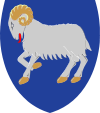
Coat of arms of the Faroe Islands
Encyclopedia

Coat of arms
A coat of arms is a unique heraldic design on a shield or escutcheon or on a surcoat or tabard used to cover and protect armour and to identify the wearer. Thus the term is often stated as "coat-armour", because it was anciently displayed on the front of a coat of cloth...
of the Faroe Islands
Faroe Islands
The Faroe Islands are an island group situated between the Norwegian Sea and the North Atlantic Ocean, approximately halfway between Scotland and Iceland. The Faroe Islands are a self-governing territory within the Kingdom of Denmark, along with Denmark proper and Greenland...
first appears in one of the mediæval chairs in Kirkjubøur
Kirkjubøur
Kirkjubøur is the southernmost village on Streymoy, Faroe Islands and the country's most important historical site.It is located on the west coast and has a view towards the islands Hestur and Koltur.-History:...
from around the 15th century. It depicts a Ram on a shield. Later uses show a Ram in a seal
Seal (device)
A seal can be a figure impressed in wax, clay, or some other medium, or embossed on paper, with the purpose of authenticating a document ; but the term can also mean the device for making such impressions, being essentially a mould with the mirror image of the design carved in sunken- relief or...
used by the , members of the Old Faroese law Court, the Løgting
Løgting
Løgting is the unicameral parliament of the Faroe Islands, a self-ruling dependency of Denmark.The name literally means "Law Thing" - that is, a law assembly - and derives from Old Norse lǫgþing, which was a name given to ancient assemblies. A ting or Þing has existed on the Faroe Islands for over...
.
The coat of arms went out of use when the Løgting was abolished in 1816. After the Løgting was reestablished in 1852 and even when the Faroe Islands were effectively outside direct Danish rule during the British occupation in World War II
British occupation of the Faroe Islands in World War II
The British occupation of the Faroe Islands in World War II, also known as "Operation Valentine," was implemented immediately following the German invasion of Denmark and Norway....
the coat of arms was not used.
After the Home Rule Act came into force in 1948 the coat of arms came into use again. Not by the Løgting
Løgting
Løgting is the unicameral parliament of the Faroe Islands, a self-ruling dependency of Denmark.The name literally means "Law Thing" - that is, a law assembly - and derives from Old Norse lǫgþing, which was a name given to ancient assemblies. A ting or Þing has existed on the Faroe Islands for over...
(Parliament) but by the Landsstýri (Government). The old title Løgmaður had been reestablished, but this time as the leader of the government. The coat of arms followed him.
On 1 April 2004, the Prime Minister's Office announced that from then on the Prime Minister and the Prime Minister's Office would use a new version of the coat of arms. This new one was based on the original from the chairs from Kirkjubøur
Kirkjubøur
Kirkjubøur is the southernmost village on Streymoy, Faroe Islands and the country's most important historical site.It is located on the west coast and has a view towards the islands Hestur and Koltur.-History:...
. The colours were inspired from the Faroese flag and golden yellow was added. The new coat of arms depicts a ram on a blue shield ready to defend. It can be used by Cabinet Ministries and by official Faroese representatives, though some still use the old symbol.

